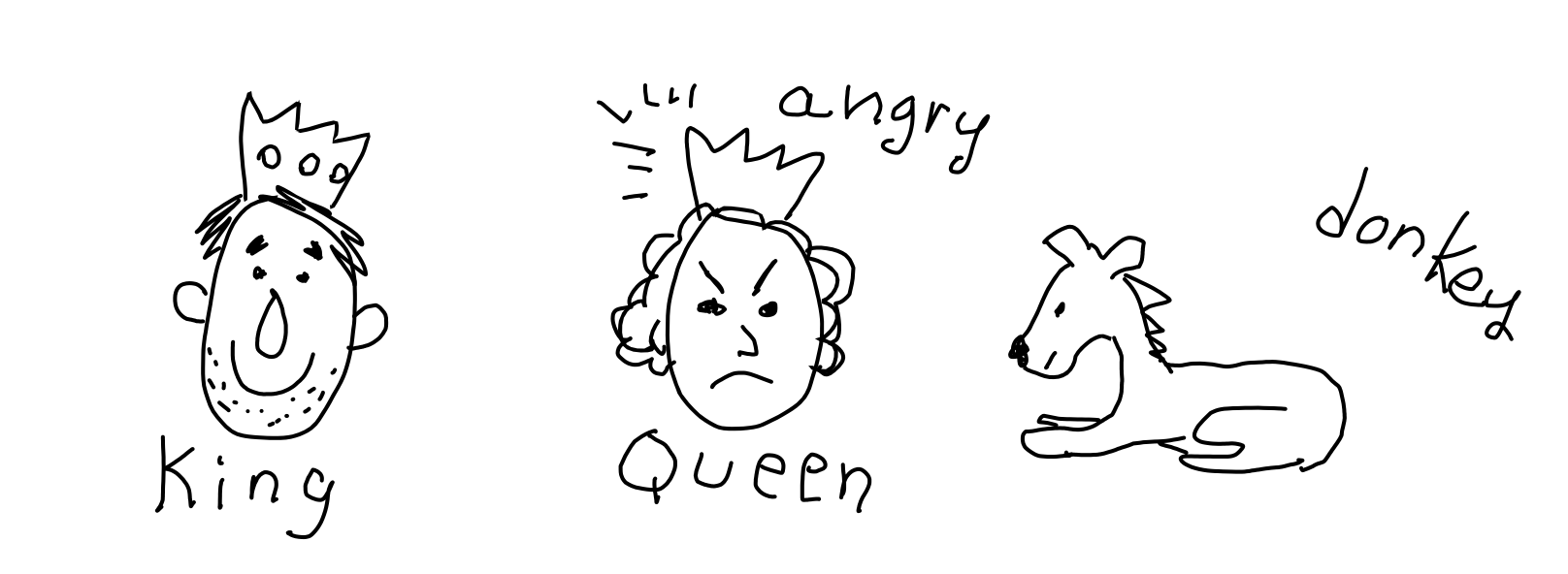Comprehension-Aiding Supplementation: CAS-Drawing
(Link to the PDF of the article)
 “Once upon a time, there was a King and a Queen. The Queen wanted a baby. One day, she had a baby, but the baby was not a human being, it was a donkey. The Queen was angry.”
“Once upon a time, there was a King and a Queen. The Queen wanted a baby. One day, she had a baby, but the baby was not a human being, it was a donkey. The Queen was angry.”
1) Drawing helps students understand what they are hearing.
When we draw a king and say, This is a king, our students likely understand the meaning of king as we say it. The image assists in making the input comprehensible. The same with queen, donkey, and angry.
2) Juxtaposing images and text increases comprehension.
When we write the word related to the drawing, (e.g., king), additional comprehensible input is supplied to some students.
3) When the drawing does not make the input comprehensible, we can add a synonym, explanation in the second language, or a translation in the first language.
Some students may not identify the drawing as a donkey for various reasons; for example, the drawing might look like a dog. The teacher can then use linguistic supplementation (explanation in the second language), saying, This is not a dog. This is a donkey. It is like a small horse. It is not a horse. It is a donkey. A donkey is similar to a small horse.”
The teacher could also or instead say donkey in the students’ first language or write it on the board quickly, erasing it as soon as everyone has seen it.
4) Drawings help keep students in the flow of the story.
Using a drawing is generally better than showing a stuffed animal, other prop, a color-copied picture, for numerous reasons. Producing such props are likely to require substantial work on the teacher’s part. The teacher will also need to do something with a prop after displaying it. In addition, an elaborate ceramic statue of a king, for example, is likely to distract students’ attention from the story, rather than helping students’ engage in the flow of events and ideas. Also, after an object is put down, it is usually out of sight, or at least it’s placed at a distance from an area for convenient visual focus (the board). A drawing on the board can remain there for students to refer back to in order to track characters, locations, or events, and for teachers to return to if they are occasioned again later in the story.

5) A simple circle with a head, arms and legs may suffice.
Some things, like dragons, may be hard to draw. But all that we need to do is draw a circle, add a head, legs and wings, and tell the students, This is a dragon!

6) It is not necessary to draw everything. We can use other kinds of Comprehension-Assisting Supplementation (CAS).
We generally only need to draw key characters, animals, places, objects, and sometimes a few simple actions. The drawings need not be precise. Stick figures are generally adequate.
7) As we draws, we can repeat the word or sentence more than one time. This provides students with more time to process the input.
While we are drawing during Story Listening, our speech tends to slow slightly and we may experience a sense of leisure to repeat words or phrases. This gives students a chance to hear the language clearly as well as more time to process the meaning of the incoming language and supplemental information, facilitating comprehension.
8) Drawing saves us time, money, space, and effort.
Story Listening is not a one-time recreational event. It is, ideally, the core of the program. We may tell a hundred or more stories in a year. If we teacher rely on visual aids such as printed-out drawings and pictures (see below), costumes, stuffed animals, and other props, we must spend time searching for them, spend money, find space to store and organize them, and endeavor to always bring just the right ones to class for each lesson. It is much simpler to draw pictures on the blackboard.
9) No printed-out pictures.
If we wish to use ready-made pictures, we must find the right pictures for a large number of words, print them using colored ink, enlarge them, and paste them onto a sturdy backing. In my experience, this requires prohibitive amounts of time and money. When we draw, none of this is needed.
10) Drawing is smoother.
If we endeavor to use a stack of printed-out pictures on a desk in front of the class, we must constantly look for and then manipulate each one as it’s needed. We will look and feel awkward and frantic as we struggle with each one picture. Drawing illustrations immediately on the board is much simpler and smoother. Vitally, it allows us to enjoy delivering stories and consequently our students to enjoy listening to them.
Blackboard and Chalk.
I prefer blackboard and chalk to whiteboard and marker for ecological, economic, and practical reasons. I prefer natural chalk to markers made of toxic ingredients and plastic. Chalk is cheaper, made from calcium carbonate, and doesn’t dry out quickly. (Dustless eco-friendly chalk is available. One resource is https://www.rikagaku.co.jp/english/items/01dustlesschalk.php)